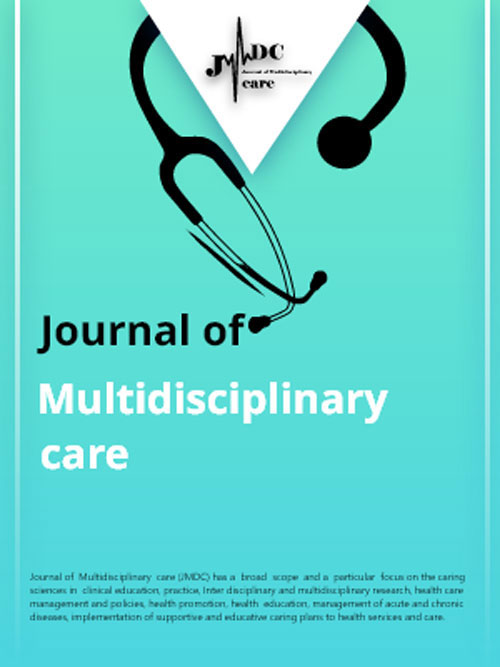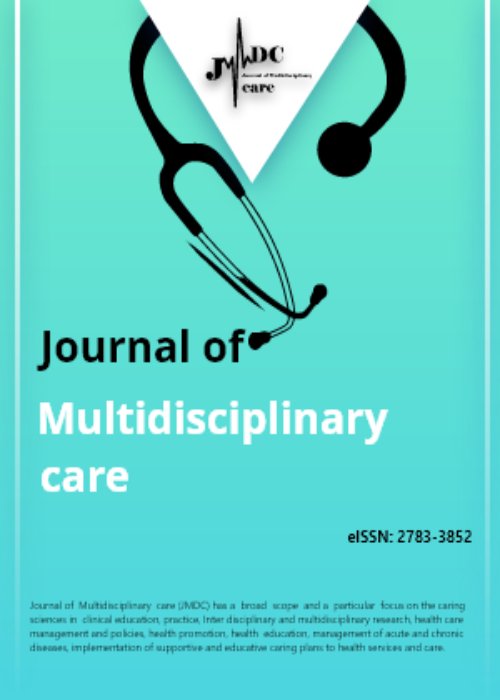فهرست مطالب

Journal of Multidisciplinary Care
Volume:10 Issue: 3, Sep 2021
- تاریخ انتشار: 1401/01/09
- تعداد عناوین: 8
-
-
Pages 95-98Background and aims
Surgery is a main treatment for some illnesses. Postoperative pain (POP) is a major postoperative concern for patients and healthcare providers. The present study aimed at comparing the effects of cold therapy and foot and hand massage on POP among patients with major surgeries.
MethodsThis quality improvement study was conducted in 2019 on ninety patients who underwent thoracoabdominal surgeries in Kashani teaching hospital, Shahrekord, Iran. Participants were randomly assigned to a control, a cold therapy, and a foot and hand massage group through block randomization with a block size of six. Participants in the control group received routine care services, while participants in the cold therapy group received twenty-minute local cold therapy three times a day for 48 hours and participants in the massage group received twenty-minute hand and foot massage three times a day for 48 hours. POP was assessed before and 48 hours after the study intervention using the McGill Pain Questionnaire. The SPSS software was used to analyze the data through the Kolmogorov-Smirnov, Fisher’s exact, chi-square, Kruskal- Wallis, paired-sample t, and Wilcoxon’s sign-ranked tests as well as the one-way analysis of variance.
ResultsThere was no significant difference among the groups respecting the pretest mean score of POP (P > 0.05). The mean score of POP significantly decreased in all groups (P < 0.05) and the amount of decrease in the intervention groups was significantly more than the control group (P < 0.05).
ConclusionCold therapy and foot and hand massage are effective in significantly reducing POP among patients with major thoracoabdominal surgeries.
Keywords: Cold therapy, Massage, Pain, Major surgery -
Pages 99-104Background and aims
Migraine is a neurologic disorder with wide global spread. Quality of life (QOL) and dietary factors are important parameters in migraine management. The aim of this study was to evaluate the relationship of mood status, QOL, and dietary intake with migraine symptoms among women with migraine.
MethodsThis cross-sectional study was conducted on 143 women with migraine aged 20–40 years who were randomly selected from two clinics in Isfahan, Iran. Data were collected using the Food Frequency Questionnaire for Assessing Dietary Patterns, a visual analogue scale for migraine headaches, the Migraine-Specific Quality of Life Questionnaire, and the Depression Anxiety Stress Scale. The serum level of calcitonin gene-related peptide (CGRP) was also measured.
ResultsParticipants’ age and number of sleeping hours per 24 hours had significant relationship with migraine severity, depression and anxiety had significant relationship with migraine severity and the duration of migraine attacks, and QOL had significant relationship with migraine severity and the duration and frequency of migraine attacks. Daily intake of riboflavin also had significant relationship with frequency of migraine attacks, while daily intake of water had significant relationship with migraine severity (P < 0.05). However, serum level of CGRP had no significant relationship with migraine (P > 0.05). The relationships of vitamin D and magnesium intake with depression were also significant (P < 0.05).
ConclusionSerum level of CGRP has no significant relationship with migraine attacks, while depression, anxiety, QOL, and magnesium and vitamin D intake have significant relationship with migraine attacks.
Keywords: Migraine, Depression, Mood status, Quality of life, Dietary intake -
Pages 105-110Background and aims
Effective communication is a key to quality nursing care delivery. However, the necessity to wear personal protective equipment and keep physical distancing during the coronavirus disease 2019 (COVID-19) pandemic has created numerous challenges in establishing effective communication in healthcare settings. The aim of this study was to qualitatively explore nurses’ experiences of communication during the COVID-19 pandemic.
MethodsThis qualitative study was conducted in 2020 using the Van Manen’s hermeneutic or interpretational phenomenological design. Participants were thirteen nurses purposively selected from the COVID-19 care ward of a teaching hospital in Bandar Abbas, Iran. Data were collected through semi-structured interviews and were analyzed using the Van Manen’s approach to phenomenological research.
ResultsMost participants were female (69.2%) and had bachelor’s degree (84.6%). The means of their age and work experience were 32.08±5.42 and 9.54±5.22 years, respectively. A total of 1312 codes were generated during data analysis, which were grouped into 28 subcategories, thirteen categories, and the four themes of being in dire straits, social life disturbances, disturbance of peace, and ray of hope.
ConclusionThe COVID-19 pandemic has challenged nurses’ communication and hence, they need emotional and psychological support to remain hopeful. Nursing managers need to support nurses and remove barriers to their effective communication in order to enable them to provide safe and quality care.
Keywords: Communication, Coronavirus disease 2019, Nurse, Qualitative study -
Pages 111-115Background and aims
Emerging infectious diseases, such as coronavirus disease 2019 (COVID-19), are among the most serious occupational hazards for healthcare providers. The aim of the present study was to assess anxiety level among nursing staff during the COVID-19 pandemic.
MethodsThis cross-sectional descriptive study was conducted in 2020. Participants were 510 nursing staff selected through a census from Valiasr teaching hospital, Fasa, Iran. Data were collected via a demographic questionnaire and a researcher-made COVID-19 anxiety questionnaire and were analyzed using the SPSS software (v. 22.0) through the chi square and ANOVA test.
ResultsThe total mean score of anxiety among participants was 93.10±7.06 and had significant relationship with participants’ age, work experience, affiliated ward, and educational level (P < 0.001).
ConclusionNursing staff suffer from high levels of anxiety during the COVID-19 pandemic. Healthcare authorities and managers need to employ strategies to psychologically support and empower nursing staff, improve their stress management skills, ensure their occupational safety, and improve their knowledge about COVID-19.
Keywords: Anxiety, Nursing, Coronavirus disease 2019 -
Pages 116-120Background and aims
Bipolar disorder (BD) is a chronic disorder with high recurrence rate and significant disability. BD is refractory to treatments and afflicted patients experience disease recurrence despite medication therapy. Therefore, appropriate psychosocial interventions are needed to improve the effectiveness of medication therapy and facilitate BD management. The aim of this study was to evaluate the effects of supportive-expressive dynamic psychotherapy (SEDP) on the outcomes of BD in men.
MethodsThis double-blind randomized clinical study was conducted in 2017–2018 using a two-group pretest-posttest design. Participants were thirty hospitalized men with BD conveniently selected from Khorshid hospital, Isfahan, Iran, and randomly assigned to an intervention (n = 15) and a control (n = 15) group. Participants in the control group received conventional medication therapy, while participants in the intervention group received conventional medication therapy as well as SEDP in twelve 60-minute one-to-one sessions. Participants in both groups completed the Bipolar Depression Rating Scale before, immediately after, three months after, and six months after the intervention. The SPSS program for Windows (v. 23.0) was employed to analyze the data via the analysis of covariance and the repeated measures analysis of variance.
ResultsAlthough the mean score of bipolar depression significantly decreased at the first posttest, the between-group difference was not significant (P > 0.05). However, the mean score of bipolar depression in the intervention group was significantly less than the control group at the second and the third posttests (P < 0.05).
ConclusionSEDP is effective in significantly reducing mood symptoms among men with BD.
Keywords: Bipolar disorder, Supportive-expressive dynamic psychotherapy, Mood symptoms -
Pages 121-125Background and aims
Patients with chronic illnesses such as stroke have different physical and mental problems and need the care and support of their family members. Family caregivers face many different problems and experience burnout during caregiving to their patients. The aim of this study was to investigate the effects of care-oriented group discussion (GD) on burnout among the caregivers of patients with stroke.
MethodsThis two-group pretest-posttest quasi-experimental study was conducted in 2019. Participants were forty family caregivers of patients with stroke randomly selected from the neurology and stroke care ward of Sina hospital, Hamadan, Iran. They were randomly allocated to two twenty-person groups. Participants in the control group received routine care services, while participants in the intervention group received routine care services in addition to care-oriented GD in six two-hour sessions. Burnout was assessed before and two weeks after the study intervention and the SPSS program (v. 22.0) was used to analyze the data through the Kolmogorov-Smirnov, paired-sample t, independent-sample t, and Chi-square tests.
ResultsGroups did not significantly differ from each other respecting the pretest mean scores of burnout and all its dimensions as well as the posttest mean scores of the personal and financial dimensions of burnout (P > 0.05). However, the posttest mean scores of burnout and its social and emotional dimensions in the intervention group were significantly less than the control group (P < 0.05).
ConclusionAs an effective strategy, care-oriented GD can be used to reduce burnout among the family caregivers of patients with stroke.
Keywords: Group discussion, Caregiver burnout, Stroke -
Pages 126-131Background and aims
Chemotherapy medications have narrow therapeutic index and high toxicity and hence, chemotherapy medications errors (CMEs) are very common and are associated with serious consequences. The aim of the present study was to evaluate the types, severity, contributing factors, and preventive strategies of CMEs in patients with cancer.
MethodsThis narrative review was conducted in 2021. Data were collected through searching the Google Scholar, Elsevier, PubMed, ProQuest, Scientific Information Database (SID), Magiran, IranDoc, and IranMedex databases. Search key terms were “adverse events”, “medication error”, “cancer”, “patient safety”, “safety management”, “chemotherapy”, “antineoplastic agents”, “neoplasm”, and “cancer”.
ResultsIn total, 125 articles were retrieved and finally, eighteen articles were reviewed. Findings came into four main categories, namely types of CMEs, causes of CMEs, severity of CMEs, and strategies to prevent CMEs. The four main types of CMEs are prescription, dispensing, preparation, and administration errors. Prescription and preparation errors are the most common CMEs.
ConclusionStrategies such as computerized physician order entry software, educational programs for nurses, improvement of nurses’ work conditions, and employment of well-trained nurses are recommended to reduce CMEs and improve patient safety.
Keywords: Cancer, Medication error, Chemotherapy, Patient safety, Neoplasm, Antineoplastic medications


